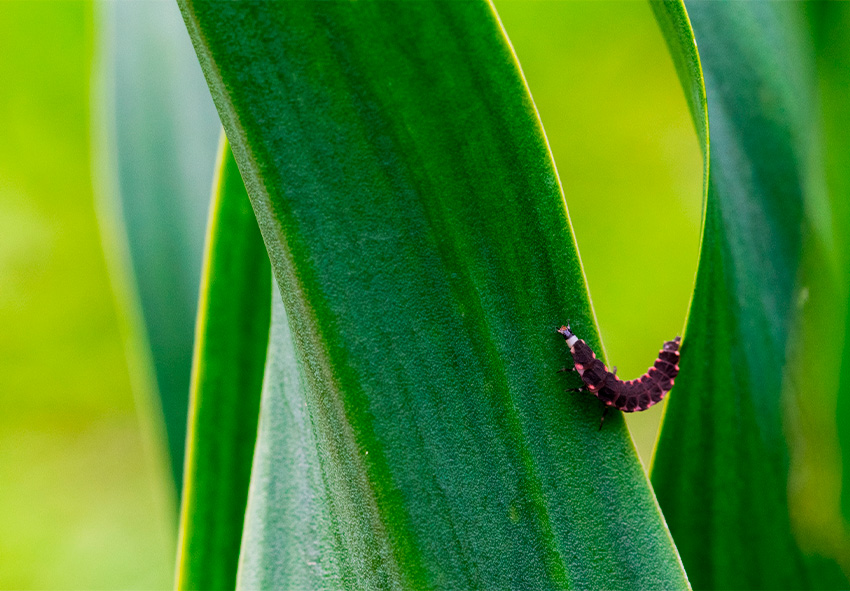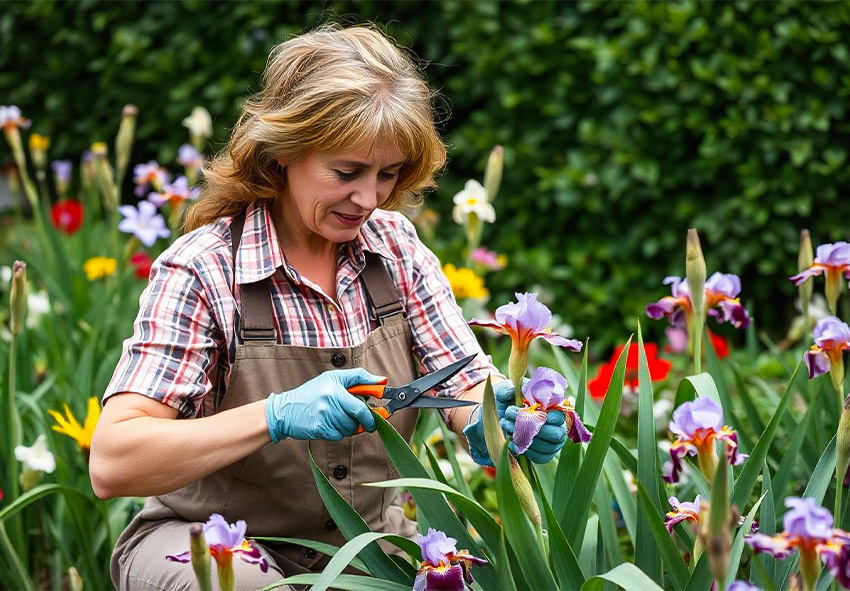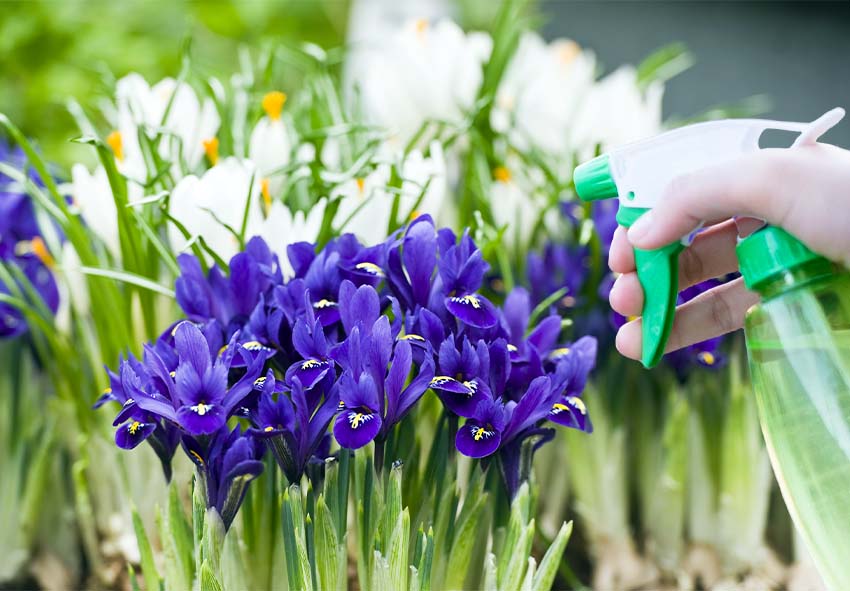Irises are some of the most stunning and versatile flowers in any garden, but they are not immune to pest problems. Healthy irises produce vibrant blooms, while infested plants can struggle with stunted growth, damaged foliage, and deformed flowers. Effective iris pest control combines early detection, preventive measures, and timely treatment to keep your plants thriving year after year. Our gardening blog is a perfect place to find all the information you need!
Common Pests That Affect Irises

Understanding the most frequent threats to iris plants is the first step in effective pest control. Recognizing the signs of infestation early can save your irises from significant damage and reduce the need for harsh chemical treatments.
Aphids
Aphids are tiny, soft-bodied insects that feed on iris sap, often clustering on new growth and flower buds. Signs of aphid infestation include curled leaves, sticky residue (honeydew), and stunted blooms. Controlling aphids early prevents them from spreading diseases and weakening your plants.
Iris Borers
Iris borers are one of the most destructive pests for iris rhizomes. Their larvae tunnel into the rhizomes, causing wilting, yellowing foliage, and rot. Early detection in late summer or early fall is crucial to prevent infestations and protect your irises from long-term damage.
Slugs and Snails
Slugs and snails thrive in damp, shaded areas and feed on iris leaves and flowers. The telltale sign is irregular holes in the foliage and slime trails. Regular monitoring, barriers, and natural repellents can help protect your plants from these common pests.
Spider Mites
Spider mites are tiny arachnids that thrive in hot, dry conditions. Infested iris leaves develop stippling, yellowing, and fine webbing. Controlling spider mites involves regular watering to reduce stress on the plants and, if necessary, using insecticidal soap or miticides.
Thrips
Thrips feed on iris buds and petals, causing streaked or deformed blooms. These pests are especially problematic during dry seasons when they multiply rapidly. Monitoring buds regularly and using targeted treatments can prevent them from ruining your flowers.
Organic and Chemical Pest Control Methods
Sometimes preventive care isn’t enough, and additional treatments are necessary. Combining organic and, if necessary, chemical solutions can help control infestations safely:
- Natural Remedies and Beneficial Insects: Introduce beneficial insects like ladybugs and lacewings that feed on aphids and thrips. Neem oil, insecticidal soap, and diatomaceous earth are effective natural treatments that control pests without harming pollinators.
- Chemical Treatments for Severe Infestations: For heavy infestations of borers or spider mites, selective chemical insecticides may be required. Apply carefully according to label instructions, ideally during early morning or late evening to protect bees and other beneficial insects.
Preventive Measures for Iris Pest Control

Preventive care is often more effective than treating infestations after they occur. Healthy plants and clean garden practices can dramatically reduce pest problems. Regular preventive maintenance also helps your irises thrive with stronger blooms and more resilient foliage. By focusing on early intervention, gardeners can avoid costly chemical treatments and keep their gardens naturally balanced.
Regular Inspection of Plants
Check your iris leaves, buds, and rhizomes weekly for signs of pests. Early identification of aphids, borers, or mites allows for quicker intervention and minimizes damage to the plant. Pay close attention to new growth and flower buds, as pests often target these tender areas first. Documenting any recurring pest activity can help you plan more effective control strategies in future seasons.
Maintaining Healthy Soil and Plants
Strong, well-nourished irises resist pest attacks better than stressed plants. Use nutrient-rich soil, proper watering, and organic mulch to promote healthy root systems and vigorous growth. Adding compost or well-rotted manure enhances soil fertility and supports beneficial microorganisms that naturally suppress pests. Rotating fertilizer applications and avoiding over-fertilization prevents weak, succulent growth that can attract aphids and other pests.
Cleaning Garden Debris
Remove dead leaves, faded blooms, and old plant debris from around your iris beds. This practice eliminates hiding spots for pests like slugs, snails, and borers and improves air circulation to reduce fungal issues. Regular cleanup also prevents overwintering of insects that can attack your plants in the next growing season. Keeping your garden tidy creates a healthier environment overall and makes it easier to spot early signs of infestations.
Tips for Ongoing Iris Protection
Consistent care and seasonal practices help maintain pest-free irises. Proper spacing, pruning, and winter preparation reduce the risk of recurring infestations. Regular attention also strengthens plants, encourages vigorous growth, and supports longer-lasting blooms. By integrating these practices into your seasonal routine, you can minimize the need for chemical interventions and maintain a healthy, attractive garden year after year.
Proper Spacing and Air Circulation
Plant irises with adequate space between them to allow air circulation. Crowded plants create humid conditions that attract pests and promote fungal diseases, so spacing and airflow are key preventive measures. Adequate spacing also ensures sunlight reaches all parts of the plant, promoting faster drying of foliage after rain or watering. Over time, this reduces the likelihood of mold, mildew, and pest infestations while keeping plants strong and healthy.
Seasonal Care and Dormancy Practices
Here’s a well-structured intro and list for the section “Seasonal Care and Dormancy Practices”, optimized for SEO using keywords like iris care, seasonal iris maintenance, iris dormancy, and pest prevention for irises:
Seasonal Care and Dormancy Practices

Caring for irises throughout the year ensures healthy growth, vibrant blooms, and reduced pest problems. Seasonal maintenance and proper dormancy practices help plants recover after flowering, prepare for winter, and minimize the risk of iris diseases and infestations. By following a structured routine, gardeners can enjoy stronger, more resilient iris plants year after year:
- Spring: Early Inspection and Clean-Up: Remove old leaves and debris from around iris beds to prevent pests and fungal growth. Check rhizomes for winter damage and prune any dead or diseased foliage. Early inspection ensures plants start the growing season healthy and strong.
- Summer: Post-Bloom Maintenance: After flowering, trim spent blooms and prune back foliage as needed. This encourages new growth and prevents seed formation that can divert energy from the rhizomes. Continue monitoring for pests and provide adequate water during hot, dry periods.
- Autumn: Preparing for Dormancy: In late autumn, cut back yellowing or dead foliage to prevent pests from overwintering in the garden. Apply a light layer of mulch around the rhizomes to protect them from frost while still allowing airflow.
- Winter: Protection and Minimal Intervention: During winter, avoid heavy disturbance of rhizomes to allow proper dormancy. Inspect periodically for signs of frost damage or waterlogging, and remove any debris that could harbor pests. Dormant irises require minimal care but benefit from a protective mulch layer in colder climates.
Conclusion
Effective pest control for irises is a combination of early detection, preventive practices, and timely interventions. By maintaining healthy soil, inspecting plants regularly, and using both natural and chemical treatments when necessary, gardeners can enjoy vibrant, pest-free irises year after year. Following these tips ensures your iris plants remain strong, healthy, and full of stunning blooms!
Frequently Asked Questions (FAQs) about Pest Control for Irises
1. What are the most common pests that affect irises?
Common iris pests include aphids, iris borers, slugs, snails, spider mites, and thrips. Each pest causes different types of damage, from leaf holes and deformed flowers to rhizome rot. Early identification and preventive care are key to controlling these pests and maintaining healthy, vibrant iris plants.
2. How can I prevent pests on my iris plants?
Preventive measures include regular inspection of leaves, buds, and rhizomes, maintaining healthy soil, and removing garden debris. Adequate spacing and proper air circulation also reduce pest-friendly conditions. Healthy, well-nourished plants are more resistant to infestations.
3. Are natural remedies effective for iris pest control?
Yes! Beneficial insects like ladybugs and lacewings help control aphids and thrips. Neem oil, insecticidal soap, and diatomaceous earth are safe, eco-friendly options to manage pests without harming pollinators.
4. When should I use chemical treatments on irises?
Chemical insecticides should be a last resort, used only for severe infestations like iris borers or spider mites. Apply products carefully according to the label, ideally during early morning or late evening to protect bees and other beneficial insects.
5. Can I order dutch irises from your online store?
Yes, you can! Our online store Dutch-bulbs.com offers a wide selection of dutch irises, including different varieties and colors. We take pride in providing top-quality plants that are carefully cultivated and shipped with care to ensure they reach you in perfect condition.
Published: 25.11.2025
